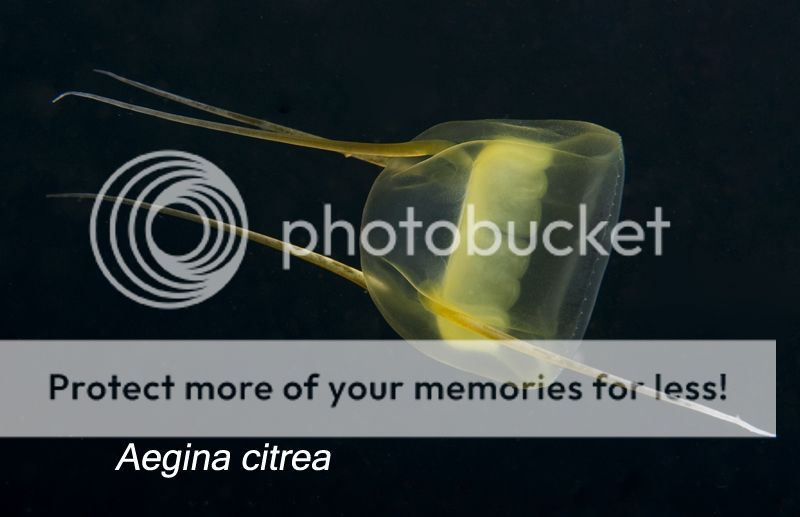Merry
Contributor
Well, not this guy.

Lately, these magnificent bulls have been lolling on the dock.


Above the barge, midwater graced us with her wonders. The bell on this lemony beauty was ~ 1 inch.


Thetys vagina is the largest species of salp. If you give one a little squeeze, you’ll find it fairly rigid, almost like plastic. That’s because the thick tunic (outer covering) is composed of cellulose.

As Thetys moves through the water, so it feeds. As it gulps along, water flows in this end…

and twenty contracting muscle bands shoot water out this end…

A filter feeder, Thetys continuously secretes a fine mucous net, which sieves the very smallest of particles from the water. The entire food-clogged net is rolled up, transported to the esophagus for consumption, and replaced by another net.

To take advantage of favorable conditions, salps have the ability to bump-up their numbers in short order. They do this by way of a form of reproduction called “alternation of generations”. This term refers to having a solitary asexual phase, alternating with an aggregate sexual phase.
At one point in the dive, I counted eight solitary Thetys and luckily spotted this one reproducing. The white structure is a “stolon”, which is producing a double chain of perhaps hundreds of individuals. Because the solitary phase is asexual, its only option is to clone itself by budding.


However, the budded, aggregate individuals are sequential hermaphrodites - meaning they have both female and male reproductive organs. Some of the individuals in the chain become females and release a single egg, which is fertilized by an older male in the chain. The baby salp is brooded and nourished within the parent until it can survive on its own. The resulting salp will be a solitary-phase animal, and can only reproduce by budding! So closes the circle.
Cyclosalpa bakeri in the asexual phase.

A chain of Salpa maxima, sexual phase.

Pyrosoma is an example of a colonial salp. Each of the little units functions just like a free-living animal, but remains imbedded in a common cylinder.

Ok, enough about salps!


Lately, these magnificent bulls have been lolling on the dock.


Above the barge, midwater graced us with her wonders. The bell on this lemony beauty was ~ 1 inch.


Thetys vagina is the largest species of salp. If you give one a little squeeze, you’ll find it fairly rigid, almost like plastic. That’s because the thick tunic (outer covering) is composed of cellulose.

As Thetys moves through the water, so it feeds. As it gulps along, water flows in this end…

and twenty contracting muscle bands shoot water out this end…

A filter feeder, Thetys continuously secretes a fine mucous net, which sieves the very smallest of particles from the water. The entire food-clogged net is rolled up, transported to the esophagus for consumption, and replaced by another net.

To take advantage of favorable conditions, salps have the ability to bump-up their numbers in short order. They do this by way of a form of reproduction called “alternation of generations”. This term refers to having a solitary asexual phase, alternating with an aggregate sexual phase.
At one point in the dive, I counted eight solitary Thetys and luckily spotted this one reproducing. The white structure is a “stolon”, which is producing a double chain of perhaps hundreds of individuals. Because the solitary phase is asexual, its only option is to clone itself by budding.


However, the budded, aggregate individuals are sequential hermaphrodites - meaning they have both female and male reproductive organs. Some of the individuals in the chain become females and release a single egg, which is fertilized by an older male in the chain. The baby salp is brooded and nourished within the parent until it can survive on its own. The resulting salp will be a solitary-phase animal, and can only reproduce by budding! So closes the circle.
Cyclosalpa bakeri in the asexual phase.

A chain of Salpa maxima, sexual phase.

Pyrosoma is an example of a colonial salp. Each of the little units functions just like a free-living animal, but remains imbedded in a common cylinder.

Ok, enough about salps!
| |
Last edited:




